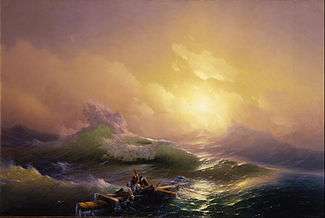The Ninth Wave
 | |
| Artist | Ivan Aivazovsky |
|---|---|
| Year | 1850 |
| Medium | Oil-on-canvas |
| Dimensions | 221 cm × 332 cm (87 in × 131 in) |
| Location | State Russian Museum, St. Petersburg |
The Ninth Wave (Russian: Девятый вал, Dyevyatiy val) is an 1850 painting by the Russian Armenian marine painter Ivan Aivazovsky. It is his best known work.[1][2]
The title refers to the nautical tradition that waves grow larger and larger in a series up to the largest wave, the ninth wave, at which point the series starts again.[3]
It depicts a sea after a night storm and people facing death attempting to save themselves by clinging to debris from a wrecked ship. The painting has warm tones, which reduce the sea's apparent menacing overtones and a chance for the people to survive seems plausible. This painting shows the destructive side, and beauty of nature.
References
- ↑ "The Ninth Wave". Hermitage Museum. Retrieved 1 November 2013.
- ↑ "Aivazovsky, I. K. The Ninth Wave. 1850". Auburn University. Retrieved 10 December 2013.
Detail from "The Ninth Wave" "The Ninth Wave," painted in 1850, is Aivazovsky's most famous work and is an archetypal image for the artist.
- ↑ Ninth Wave Theory at freaquewaves.blogspot.com
External links
 Media related to The Ninth Wave by Ivan Aivazovsky at Wikimedia Commons
Media related to The Ninth Wave by Ivan Aivazovsky at Wikimedia Commons
This article is issued from Wikipedia - version of the 11/19/2016. The text is available under the Creative Commons Attribution/Share Alike but additional terms may apply for the media files.